The Value Ladder: How to Improve Online Course Sales by Segmenting Your Audience and Product Offering
10 minute readYou are selling a great program; an online course where you offer tons of value to your students.
You spent money and time on marketing... but nobody is buying it.
There is nothing more demotivating than devoting hours and hours to build the perfect online course - only to launch it and see no interest from your audience.
Have you ever considered that maybe people are just not ready to buy it?
Having a value ladder can help.
In today’s article, you will learn all about creating a value ladder for your online course business, which will help you match different types of customers to product offerings they are ready to purchase.
What is a Value Ladder?
A Value Ladder is a collection of products arranged in order of increasing value and price, and designed to meet a customer's needs and desires at each step in their journey.
It can help you create a visual representation or graph of your product offerings and match them to their relative audiences.
Try organizing your lineup of products - from the least expensive and least valuable to the one with the highest price and value. By arranging your offerings this way, you are able to match them with people who are on the journey to becoming your customers, in all their different stages (from awareness to interest to purchase).
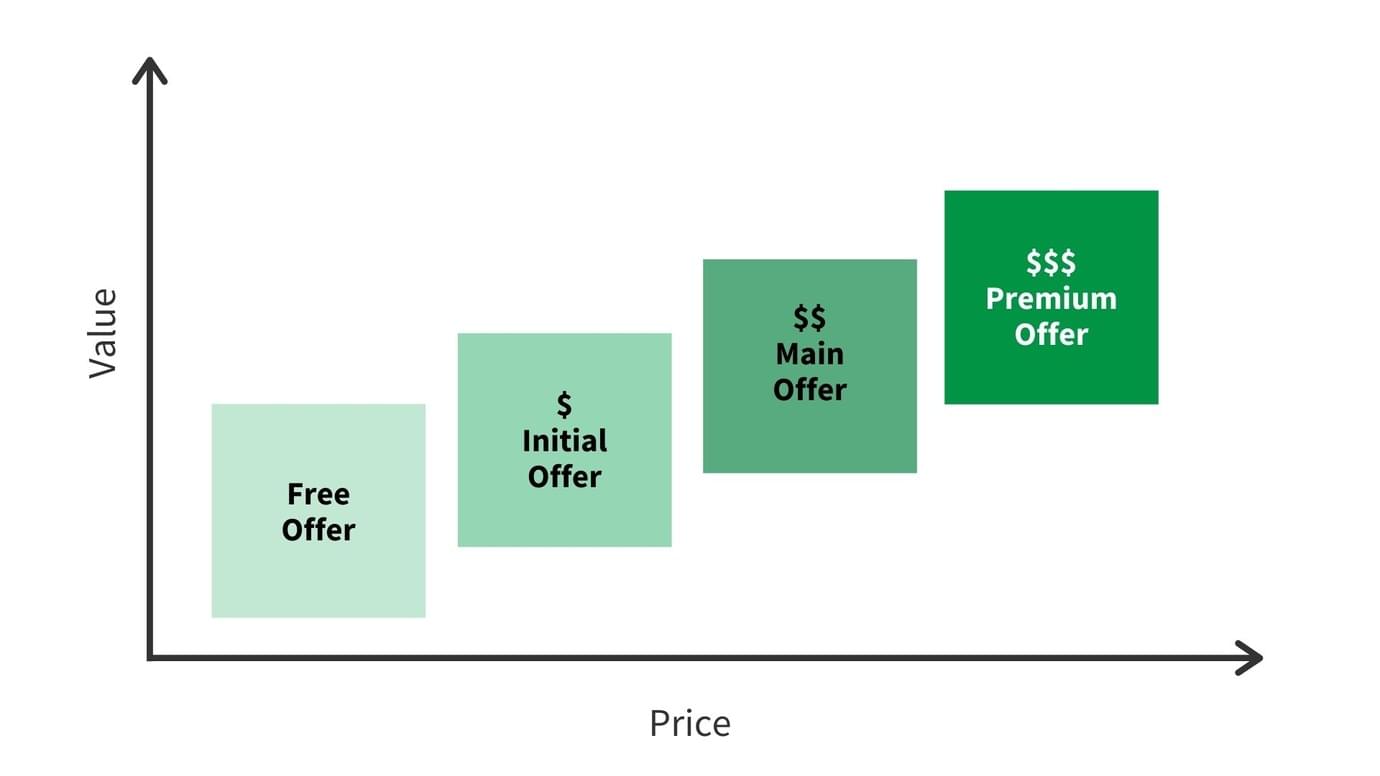
For each stage of the customer journey, the value ladder provides a specific product to offer to your audience, which will bring them closer to your end goal (purchasing the highest value-price offering). Going through the process of creating a value ladder can help you find gaps in your product offering, and help you determine the end purpose and goal for each of the online courses and digital products you have to offer.
For example, let’s say that you are selling a $500 online course about Japanese Cooking. If you promote it to people who have never heard about you or your product before, the chance they will buy it is very slim, if not inexistent.
People will be more likely to purchase your product if they are familiar with you, or have already bought something from you in the past.
So before pitching the $500 online course, start by giving away a free mini-course about Japanese appetizers. If people are interested in the free offer, you could retarget them with a low-price product, a $30 e-book about Japanese recipes, and so on, until your reach the highest product in the value ladder - your full $500 online course about Japanese Cooking.
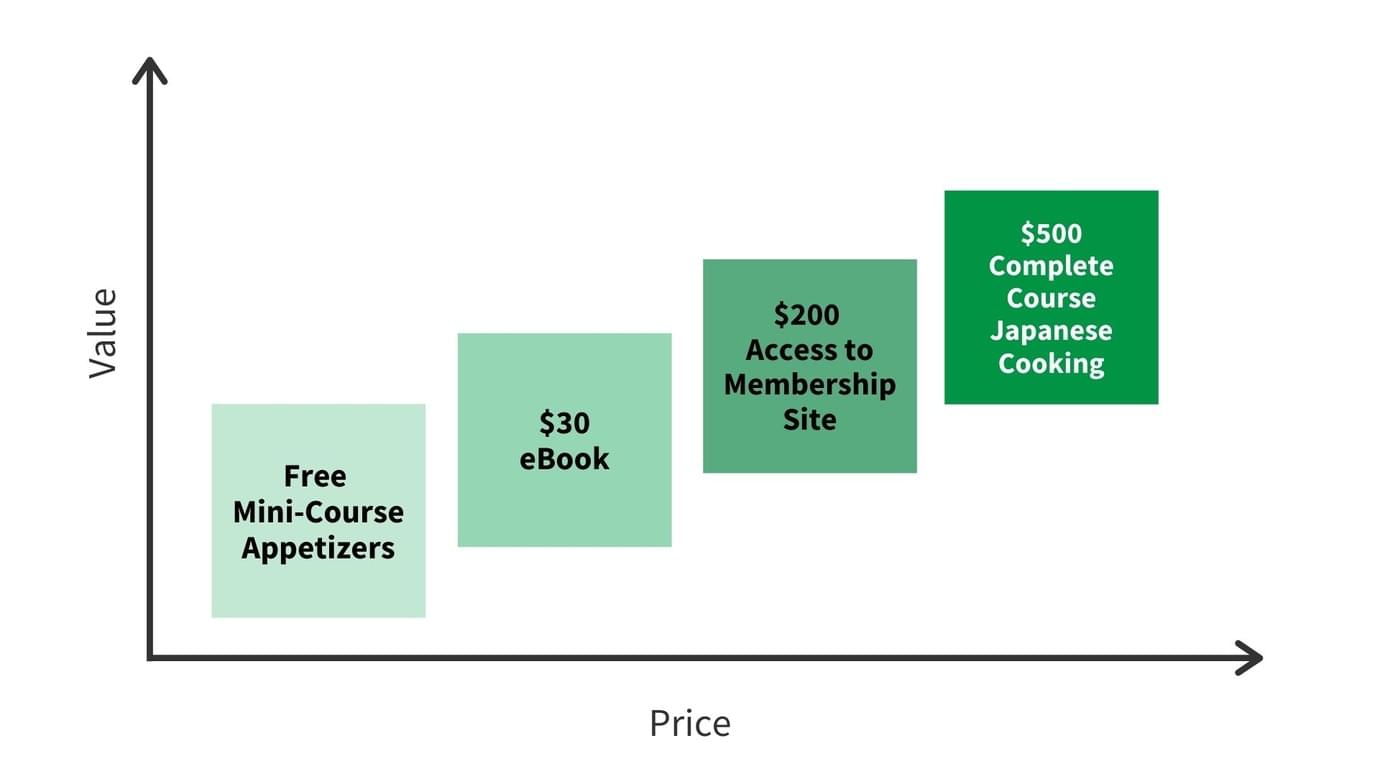
This is how the value ladder works. It helps you guide your potential customers through your product offerings and gently prepares them to purchase the product with the highest value and price.
Depending on the size of your business and how many product offerings you have, your value ladder can take different shapes and forms. If we apply the same example of the Japanese cooking course, a more complex value ladder could include more product offerings, as shown in the picture below.

What if you only have one product offering?
It is not wrong to only have one product offering in your business model.
The question you need to ask yourself is: what do you wish to achieve with your online business?
If the answer is “I just want to make a little extra money and not put too much effort into it” then having a single product offering is perfectly fine!
However, if you wish to scale your business and build a community with a loyal audience who trusts you, then you should think about creating a value ladder.
That said, a value ladder is not a speed ticket to success. You can be successful with one product offering as well, however, you probably would need to invest a considerable amount of time and money into advertising, to turn cold audiences into customers. While structuring a value ladder for your business is a smart way to guide your audience through their customer journey.
Why Should You Have a Value Ladder?
Imagine that a random person came up to you in the streets and asked you:
“Hey, I have a $3,000 online course that will change your life, wanna buy it?”
You probably would think they are insane.
Maybe the $3,000 online course could actually change your life, but that random person has not earned your trust and has not been preparing you to make the purchase. In other words, they have not inserted you in their value ladder.
Let’s see what other benefits structuring a value ladder can bring to your business:
Creates Trust Among Your Audience
If you manage to create a clear customer journey that guides them through your offerings and eases them into your program, your customers will gradually learn about you and start trusting you.
The first step in the value ladder should be a free or low-priced offering that provides a high value compared to its price. For instance, you could give away a free video, or presentation and so on.
By giving away free value, you immediately gain the trust of potential customers, while at the same time establishing your mentorship in the industry.
If people get your free first step of the value ladder, they will be more inclined to purchase a slightly more expensive product from you, as they benefited from the free offering.
While you move your customers through the value ladder, they will repeatedly see your name, hear about your products and brand. Even if they don’t purchase right away, you’ll be able to establish yourself as an expert in your field and grow their trust towards your business.
Retargets Existing Customers
Did you know that existing customers are much more likely to purchase from you again?
After their first purchase, there is a 27% chance that the customer will return to your store.
After their second purchase, the percentage increases: there is now a 54% chance of them coming back for a third purchase!
The value ladder leverages the power of existing customers by retargeting those who showed interest in your low-tier offerings and accompanies them to the next level, once they are ready.
Extends the Customer Lifetime Value
The customer lifetime value (also known as LTV), includes the total amount of money that an average customer is expected to spend in their lifetime, on your business.
If you only sell one online course, and you don’t offer any products for your existing customers, you are missing an opportunity to maximize their lifetime value.
Repeat and loyal customers have a high lifetime value. The value ladder can help you nurture and retain those types of customers.
Creates Upselling Opportunities
Not only do repeat customers are more likely to purchase from you again, but they also spend more on their next purchases!
Researches found that your loyal top 10% of customers spend 3 times more per order than the remaining 90%, and your top 1% of loyal customers spend 5 times more than the other 99%.
A Value ladder can help you upsell your products to the most loyal customers, who are more likely to purchase your high-tier offerings compared to new customers.
Segment your Audience First
Before getting started with implementing the value ladder system for your business, you need to understand the different audience segmentations.
Prior to being ready to purchase your product, potential customers undergo different stages of the “buyer cycle”.
A simple way to segment these stages is described by the AIDA model, originally developed in the 19th century. The model is still used today in most successful advertising strategies.
AIDA defines all the different steps that potential customers go through in their emotional journey before making a purchase: Awareness, Interest, Desire, Action.
Why is it important to segment your audience before applying the value ladder principles to your business model?
Each step of the value ladder is designed for a different audience type. Before being ready to purchase any of your products on the value ladder, your audience must undergo a process of sensibilization towards your business. More precisely, they need to go throw the AIDA stages of Awareness, Interest, Desire, and Action.
The Awareness stage is where potential customers first hear about your brand. At this stage, they are not familiar with your product and they do not trust you yet. The awareness audience will not respond well to your high-end product offerings, as they are not ready to invest a large amount of money in a product they have never heard of before.
At this stage, it is most effective to propose your free or initial offer to any potential customers. These types of products offer a high value for free or low price, with the aim of introducing new customers to your business and generating new sales leads.
The Interest stage of the AIDA model includes those potential customers who have heard about your brand and show some interest in your products. These are people who may have seen your ads or visited your website: however, this does not mean that they are ready to purchase your premium offers yet.
At this stage, it is important to keep providing value to these customers by slowly introducing them to the different product offerings in your value ladder.
As your leads go throw the different steps of the value ladder, some may enter the Desire stage of the AIDA model, where they are now familiar with the brand and see the potential in your product offerings.
This type of customer is ready to be taken to the next level: purchasing one of your products (Action).
It is important to note that in order for your customers to reach the “Action” stage of the AIDA model, and therefore purchase your product, they first need to go throw all the other stages (awareness, interest, and desire).
However, depending on the customer, they may reach the Action stage earlier or later. Some customers may go through all of the steps in your value ladder before purchasing your premium offering, while others may only visit your website once and be ready to commit.
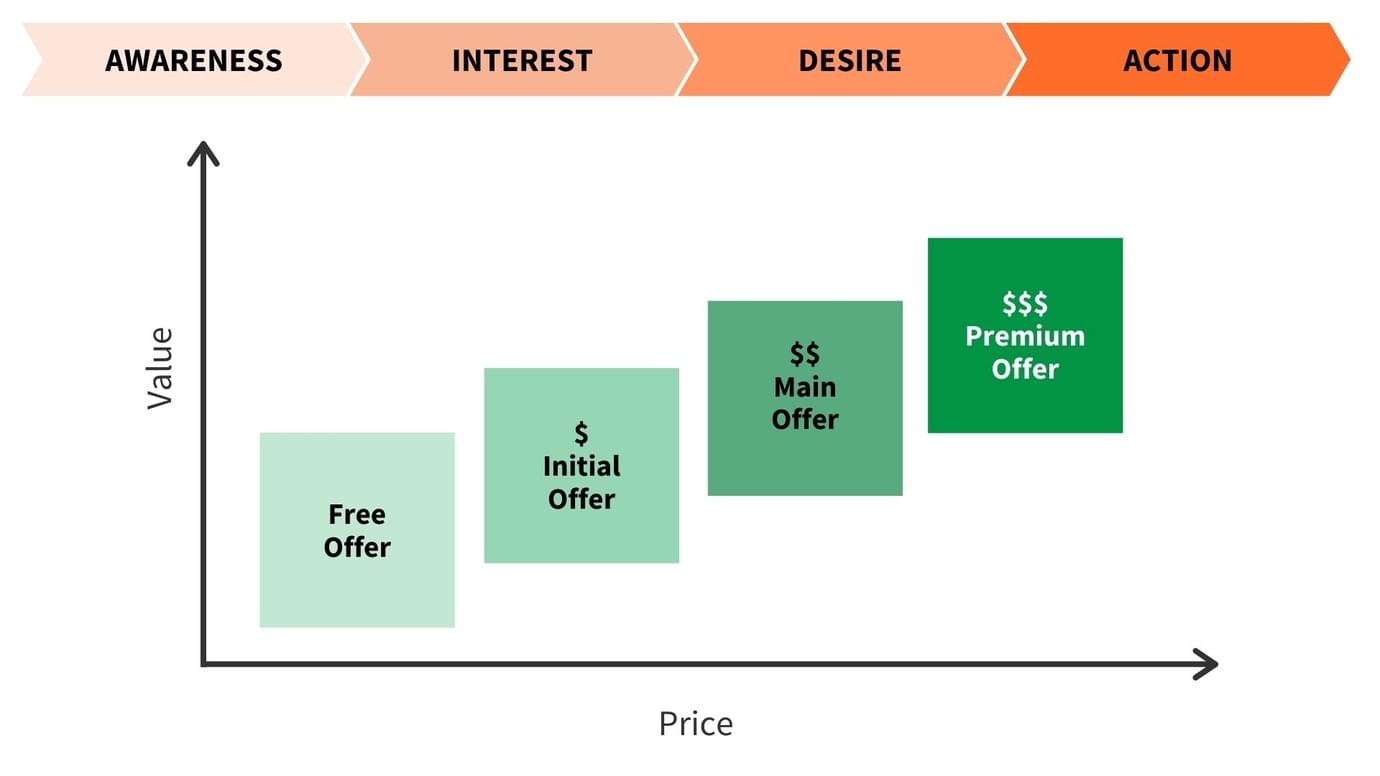
How to Structure your Value Ladder
Depending on your business model and how many product offerings you have, your value ladder is unique and can change.
The most important thing is that you arrange your product offerings from the least valuable and less expensive, to the highest in value and price, and that you match them with their corresponding audience groups.
So to have a value ladder all I have to do is create a bunch of products and try to sell them?
Wrong.
Your value ladder will only work if you place your product offerings strategically. Having many products differentiations does not mean that you are using your value ladder correctly.
You need to make sure that your potential customers are being walked through your product offerings as they start their buyer journey - from becoming aware of your business to being ready to purchase your main offering.
#1. Free Offer
The first step of the value ladder is probably the most important one, even if you won’t immediately profit from it.
It consists of giving away a free (or extremely low-priced) product to a new audience.
The purpose of this free offer is to generate new sales leads. This offer should provide free value or solve a specific problem your audience is facing.
As you are giving it away for free, potential customers won’t think twice about getting it, and it is a great way to introduce them to your brand and start building mutual trust.
As this is your first touchpoint with potential customers, the offer should be highly valuable to them, in order to provide a reason to come back to your site or purchase other products next in line in the value ladder. So even if it’s free, try to find the right balance between giving out as much value as possible, but without making your other paid offering less valuable.
Examples of a free offer could be a mini-course, an eBook, tutorial videos, blog posts, a webinar replay, a podcast episode, an explanatory PDF, and so on.
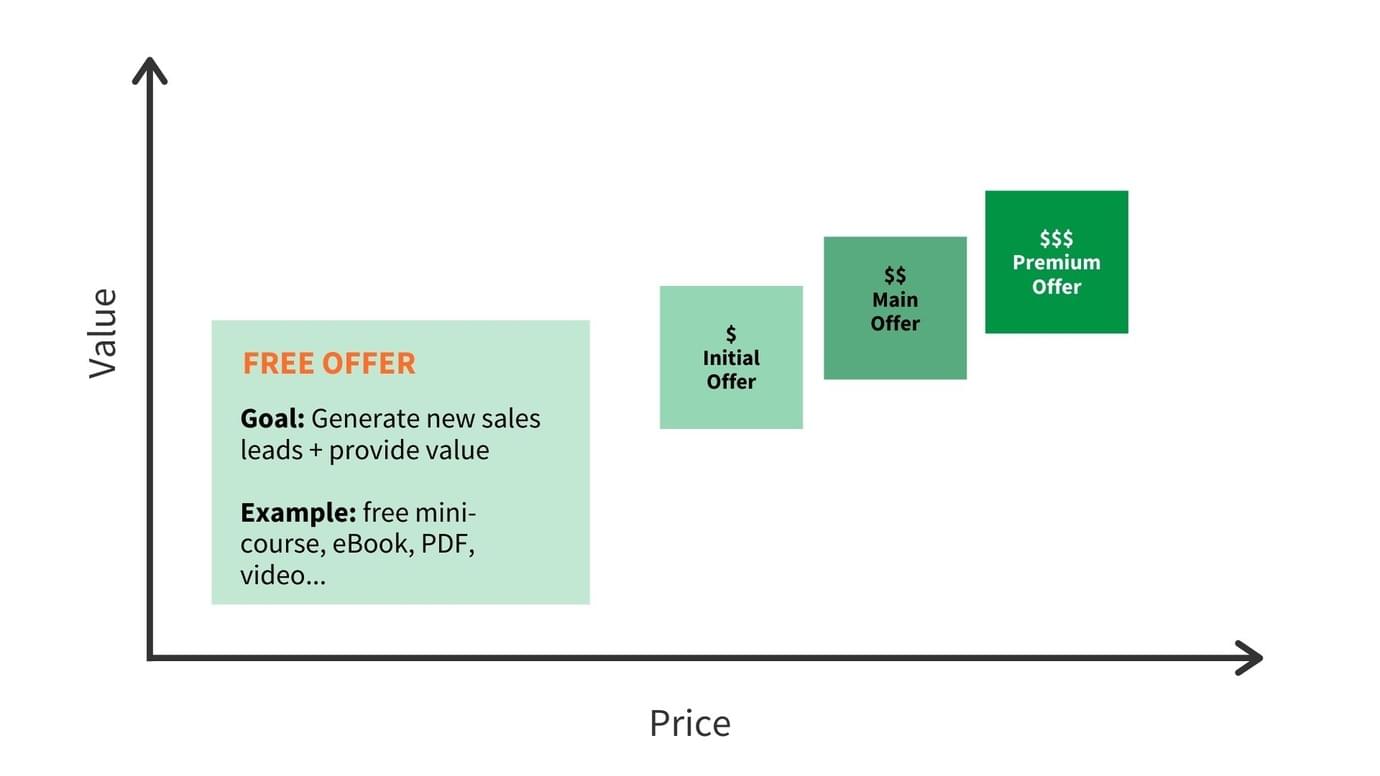
#2. Initial Offer
Once potential customers get your free offering, it’s time to present them with the initial offer.
The initial offer consists of a low-priced product that provides more value or goes deeper in solving that same problem of your audience.
As you are still building trust and establishing yourself as an expert in your niche, the initial offers must be high in value as well. Regarding its price, this may vary depending on your business, however, it should be something your audience can afford and sees as reasonable (generally speaking between $5 and $50 is considered a good price for an initial offer).
Similar to the first step of the value ladder, you should not aim at making a huge profit from this offer, rather cover your advertising costs.
Examples of the initial offer could be a paid eBook, a small course, a digital product, and so on. Try to keep your one on one solutions for a higher-priced stage in the value ladder.

#3. Main Offer
Your main offer is where you can start being profitable. It should provide a greater value compared to the previous offerings and should be the core of your business model.
If you are an online course creator, your main course or membership program should be located at this stage of your value ladder.
By now your customers have purchased or received at least one other product from you and they are familiar with your brand. Their trust level should be enough to justify the investment.
The results your main offer provides should be clear to interested customers, as a way to incentivize the most skeptical students.
Learn more about structuring your online course around a result in this article from our blog: The Most Important Thing You Need to Know When Creating an Online Course - Build it Around a Result
Examples for your main offer include your main online course or membership program, 1 on 1 session, consulting services, etc.

#4. Premium Offer
Regardless of how many steps you have on your value ladder, at the top you should position the premium offer.
This is the ultimate product on the chain, that carries the greatest value proposition and the highest price.
This offer is aimed at those customers who have experienced your teachings already and are in need of more: it should not be something directed to the general public, rather a unique, personalized offer reserved to your most loyal customers.
Examples of this type of product include a more comprehensive online course, a tailored program, 1 on 1 coaching, a done-for-you solution to a specific problem.
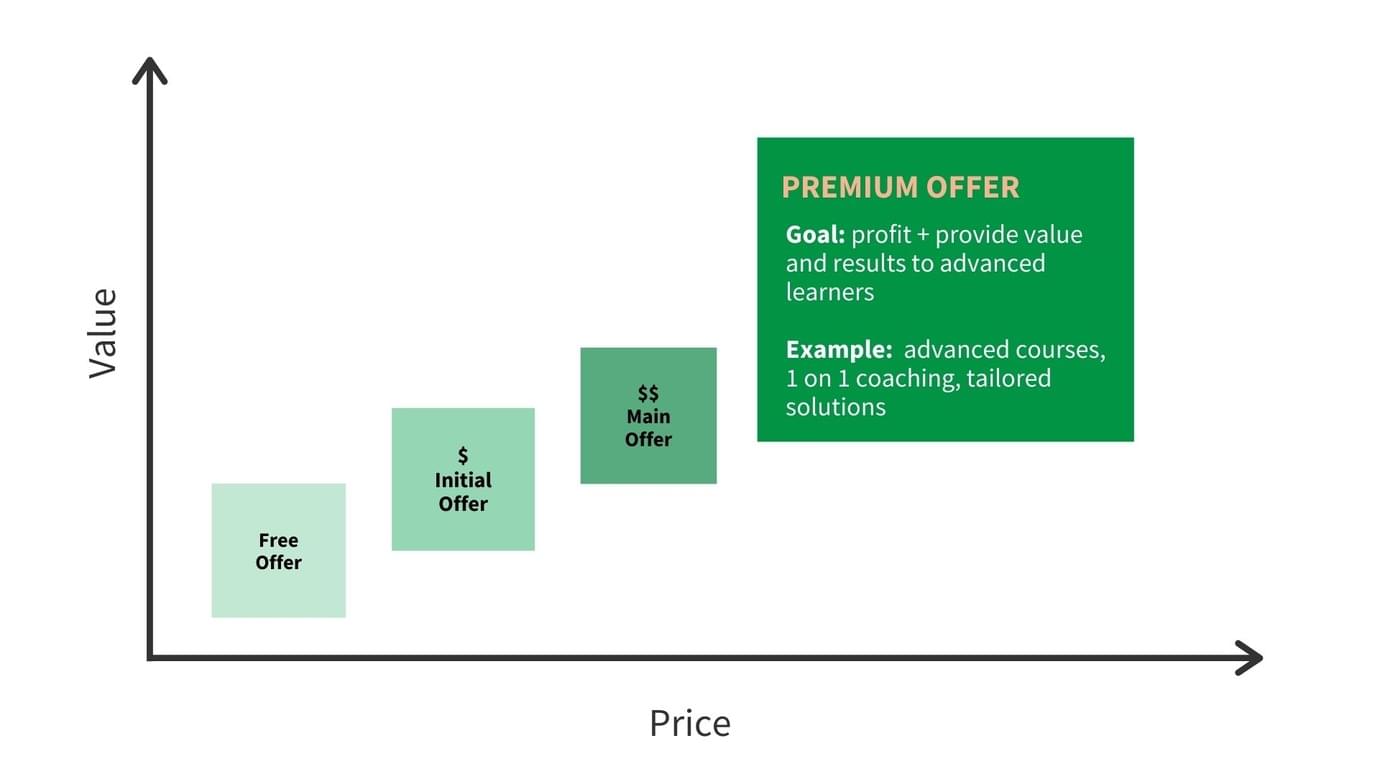
Conclusion
Creating a value ladder and applying it to your business model is a great way to guide your audience through their customer journey, gradually earn their trust, and preparing them for your premium offerings.
The way you structure the value ladder highly depends on your business and the number of products you are selling.
If you are an online course creator with Heights Platform, you have no limits on how many courses, bundles, and digital products you can sell to your audience. Heights Platform makes it easy for you to integrate a value ladder into your business, and profit from it.
Are you using a value ladder in your online course business?
Create Your Online Course Today


